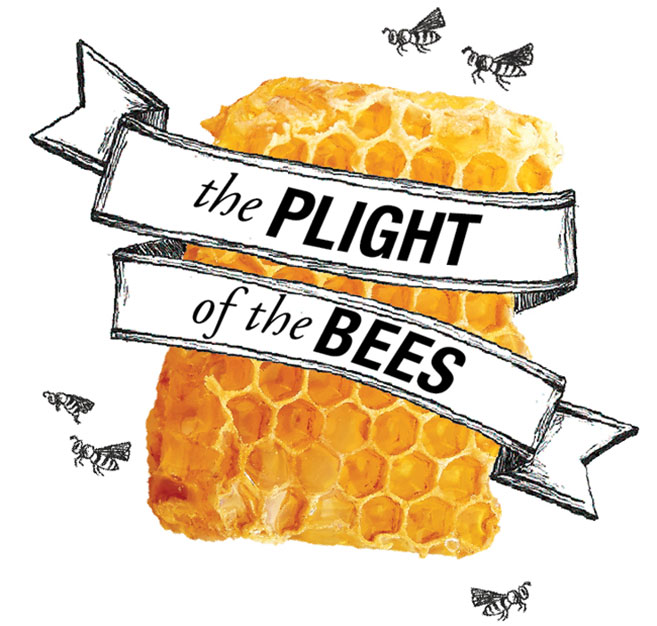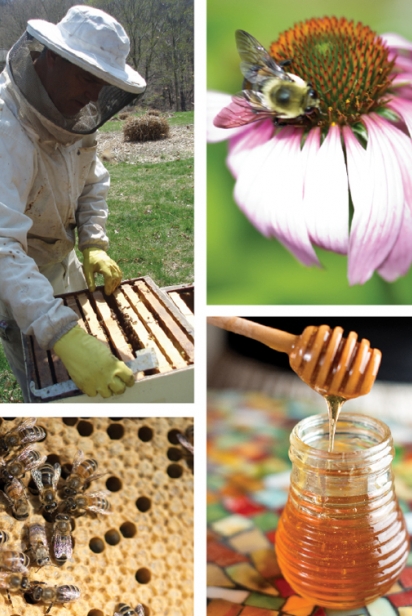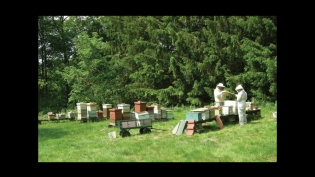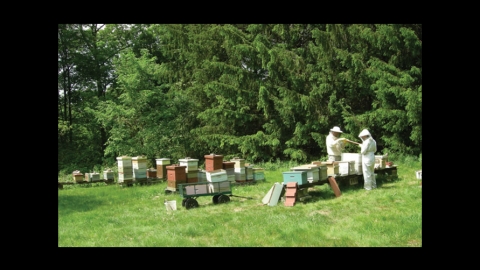The Plight of the Bees
Research by Elsa Hellberg | Illustrations by Sasha Henry + Allie Wist
If the bee disappeared off the surface of the globe, then man would only have four years of life left. No more bees, no more pollination, no more plants, no more animals, no more man.” — Albert Einstein
Honeybees are our friends. And while they’ve been nourishing, employing, and healing us, we’ve been killing them. In light of the current state of the bee population, Einstein’s quote is shocking, scary, and very pertinent to Western Pennsylvania and beyond.
Honeybees pollinate one third of the world’s crops — in other words, one in every three bites of food is brought to you by bees — not to mention 90 percent of wild plants. Chances are, you owe your favorite fruits, nuts, and flowers to the hard work of honeybees. It’s hard work that they do for free, farmers note, as this natural pollination process is a major factor in keeping many farms in business. Honeybees inject about $14 billion into the U.S. economy annually, just by engaging in their natural patterns. But following nature’s course is becoming nearly impossible for many bees because of a range of pesticides called neonicotinoids that, studies suggest, confuse, weaken, and kill entire colonies, contributing to a phenomenon called Colony Collapse Disorder (CCD). CCD emerged in the mid-2000s, the same time that neonicotinoids gained widespread usage. And while these pesticides are likely a major culprit, mites, deforestation, viruses, and pathogens remain contributing factors to the mysterious phenomenon as well. “[CCD] startled beekeepers because, unlike typical winter losses, the bees are simply gone,” says Jennie Wood, beekeeper at SteffesWood Apiary.
Though not due to Colony Collapse, SteffesWood lost eight out of 15 hives this winter, a considerably higher number than usual. Some keepers saw even higher losses. Steve Repasky of Meadow Sweet Apiaries lost approximately 70 percent of his hives this year — presumably due to CCD. Karen Mosholder of BumbleBerry Farms also fell victim, losing about 80 percent of her bees. “This was a devastating blow!” says Mosholder. “I really care about them and to have this happen just makes me sick.” Upwards of 10 established apiaries populate Western Pennsylvania, not including urban and suburban hive keepers, and luckily, only a few locations experienced the effects of CCD. But unusual and large losses have hit most of these beekeepers’ populations, causing many to focus on nurturing their remaining colonies, rather than flourishing their businesses.
In fact, 30 percent of all local hives were lost in a drought last year, representative of the 31.1 percent lost nationwide. But that percentage may only be increasing: 50,000 bumblebees were found dead in a single location in Wilsonville, Ore., this June, prompting the Oregon Department of Agriculture and local pollinator-supporting groups to investigate. The suspected cause? Dinotefuran, a highly toxic neonicotinoid, had been sprayed on the trees surrounding the lot just days prior.
Do bees in Western Pennsylvania — which are responsible for pollinating such crops as pumpkin, cucumber, apple, pear, raspberry, squash, and blueberry — face similar threats? We turned to Joe Zgurzynski, master beekeeper of Country Barn Farm and an instructor for Burgh Bees, Pittsburgh’s first urban beekeeping society, about the current threats to Pittsburgh’s bee community. Honeybees are suffering on many fronts, he explained. Poor nutrition, unprecedented stressors, and two new pathogens in the United States, Insect Iridescent Virus and Nosema ceranae, are all to blame for the honeybee decline. Organizations like Burgh Bees, whose mission is “to educate beekeepers and promote beekeeping as a vital part of sustainable agriculture in Pittsburgh and its suburbs,” are fighting to reinvigorate the population through both action and education. Other local establishments are contributing to the fight, too: Chatham University’s Eden Hall campus is home to an official apiary that is used to research and develop its environmental sustainability program. (Read more about the program in the sidebar at right.)
Losing honeybees will do more than decrease the stability of both crops and the people who provide us with them, though. It would also hinder exciting new research that suggests bee venom is a pain reliever and may even fight HIV and tumor cells. Properties of bee venom resist the quickly mutating virus strain in HIV, and scientists are hopeful that it may provide a long- awaited remedy.
Apitherapy, therapy with bee venom, helps patients with chronic pain as an alternative healing method. Connie Frank, who practices apitherapy in Rector, Pa., is both an advocate for and receiver of its healing properties. “I bear witness to their healing effects,” she says. “I now do bee therapy on myself for carpal tunnel, migraine headaches, and back pain.”
Frank, who was introduced to apitherapy by a friend suffering from multiple sclerosis, has invested her time, money, and energy into an animal that she regards with “awe, gratitude, and amazement.”
Honeybees, we’ve found, are far more integral to our health than we would have imagined. Whether pollinating one third of our dinner plates or easing our neighbor’s arthritis, honeybees are literally swarming our lives. Taking away bees means taking away present and future opportunity and stability — and we think honeybees are worth our time. “When the bees go…our food sources go, [and] so does the human population,” says Mosholder. “We are intrinsically linked to our environment, and we need to take better care of the world around us.”
BEE INFORMED
Each summer, Chatham University offers a two-week interdisciplinary sustainability course at its Eden Hall Campus. Students from around the country enroll in the residential Food, Farm, and Field course, which incorporates classroom learning, group discussions, field trips, and hands-on activities on the farm and in the kitchen. “Because we take an interdisciplinary approach in this program, we can provide a whole range of perspectives on the way our food moves through our environment and our communities,” says Alice Julier, director of the Master of Arts in Food Studies program at Chatham. Part of this multifaceted approach to education includes Eden Hall’s student and staff-run apiary, established in 2010. The hive houses about 60,000 bees that collect pollen within a two-mile radius, covering about 8,000 acres — more than 20 times the size of the 388-acre Eden Hall Campus. “Although they are so important to life on this planet, bees are often misunderstood and maligned,” says Dr. Sherie Edenborn, assistant professor of microbiology. “By establishing this apiary, we can re-educate people about how special these insects are and how so much of our own lives are impacted by their role in nature.” Chatham University Eden Hall Campus, 6035 Ridge Road, Richland Township.
SPECIAL EVENT!
Join Edible Allegheny Magazine at Wild Purveyors (5308 Butler St., Lawrenceville) on August 15 from 6-8 p.m. for The Plight of the Bees, an informative and tasty evening, featuring experts from the local bee community and benefiting Chatham University’s Eden Hall Campus.
For tickets, visit showclix.com/event/plightofthebees.
Whole Foods is busy with bees, too!
The Share the Buzz movement donates a portion of certain products to the Honeybee Conservancy Project at Rodale Institute where they’re working to educate and promote natural and sustainable beekeeping. Tips to start? Bee organic, bee a gardner, and bee smart about your shopping! wholefoodsmarket.com/sharethebuzz
HOW YOU CAN HELP:
1. Plant a bee-friendly garden. Whether you prefer herbs, flowers, or fruits and veggies, you can help wild honeybees thrive by planting bee-attracting plants. Zinnias, buttercups, peppers, and thyme are among many plants that help bees thrive.
2. Purchase pesticide-free products. Look on the labels of your household cleaners and attempt to eliminate the dangerous products from your cabinets. This can be a difficult process, especially because an organic label does not guarantee a pesticide-free product (just pesticide-better), but making conscious decisions can pave the way to a healthier environment for bees.
3. Buy local honey! Not only are there some un-bee-lievable honey recipes to try, but the medicinal properties of honey are proven to minimize allergies and help burns. “Eating local honey increases one’s immune system and decreases allergic responses to local plants and trees,” says Frank.
4. Support local apiaries. Besides buying honey, contribute to local bee farms like Burgh Bees, where the opportunity to tend your own hives is offered.
5. Contact humane bee removal services, like those provided by Steve Repasky of Meadow Sweet Apiaries, if you need to have a hive safely removed from your yard.
6. Feeling ambitious? Start your own apiary!









